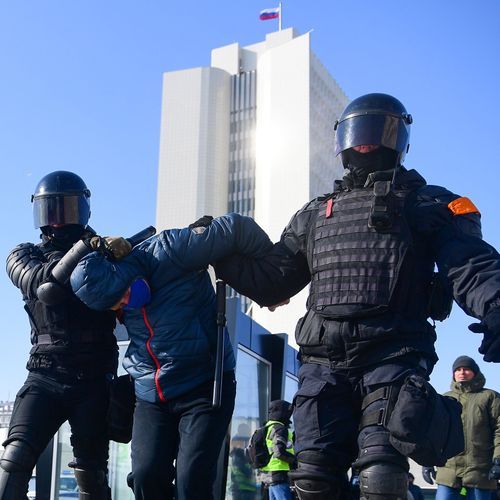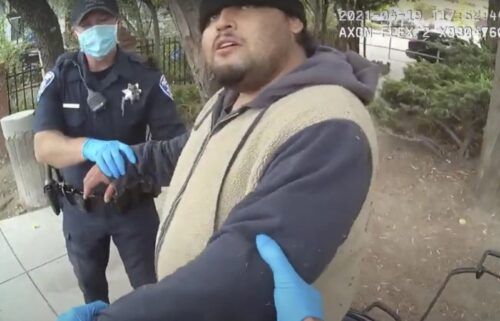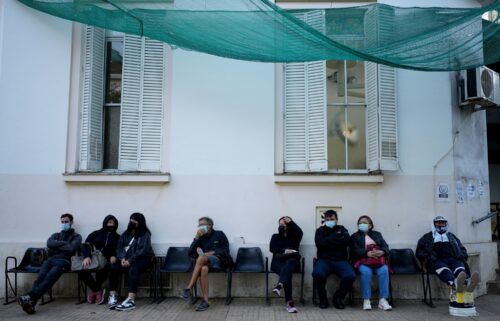Kremlin meets Russian protesters with fiercest crackdown in years

Thousands of people in Moscow and across Russia who took to the streets Sunday were met with the harshest show of force the country has seen in recent years.
Protesters throughout the country had gathered for the second weekend in a row to support jailed opposition leader Alexey Navalny, who has been held by Russian authorities since mid-January.
More than 5,000 people were detained in at least 85 cities as of late Sunday, according to the independent monitoring group OVD-Info — a record since 2011.
In Moscow, the capital, more than 1,600 people were arrested, including Navalny’s wife Yulia, though she was later released.
Navalny himself has been behind bars since shortly after he arrived in Moscow on January 17. The longtime Russian dissident had spent the previous several months in Germany where he was recovering from being poisoned with Novichok, a powerful nerve agent. Navalny accused the Russian government and President Vladimir Putin of trying to kill him, an allegation the Kremlin has repeatedly denied.
A joint investigation last month by CNN and the investigative group Bellingcat implicated the FSB in Navalny’s August poisoning, piecing together how an elite unit at the agency followed Navalny’s team throughout a trip to Siberia, at the end of which Navalny fell ill from exposure to military-grade Novichok.
Russia has denied involvement in the case.
Protests across country
Sunday began with supporters of Navalny planning protests in at least 120 cities across the vast country, starting at noon local time in each location.
Russia’s capital on Sunday was more reminiscent of a besieged fortress than a modern city. Cordon after cordon blocked off entire blocks. Countless vans were readied to bring detainees to police stations, and riot police donned heavy-duty uniforms to clean the streets of protesters.
They had also sought to gather in front of the Russian Federal Security Service headquarters, or the FSB, which they believe is behind Navalny’s Novichok poisoning in August. But in an unprecedented move, Moscow authorities closed seven subway stops in the city center and cut short bus routes to stop the demonstrators from gathering. The areas surrounding the FSB building and the Kremlin were barricaded from early morning.
The organizers were then forced to change locations, forcing riot police to catch up with marching columns of people every time Navalny’s team changed gathering points across the city.
Protesters in Moscow eventually decided to march down to the Matrosskaya Tishina detention center, where Navalny is being held before his trial next week. Local authorities closed metro stops one after another leading up to the detention center in Moscow’s northeastern Sokolniki neighborhood.
“Let him go!” and “Russia without Putin!” chants could be heard as protesters walked along the snowy streets toward the facility. Three more subway stops along their path were shut down at the police’s request in an attempt to stop more people from joining.
Before her reported detention, Navalnaya posted a picture on Instagram showing her taking part in a protest in the area. “It’s great in Sokolniki today!” Navalnaya said in the caption, alongside a photo showing her, hands raised, followed by a column of people.
Navalnaya was detained “during a peaceful walk” by police officers who did not identify themselves or provide any reason for the detention, according to Vyacheslav Gimadi, head of the legal department of Navalny’s Anti-Corruption Foundation (FBK). She was later released.
Russia’s interior ministry warned citizens not to participate in the “unauthorized” protests in an Instagram post. Russian federal law requires organizers to file an appeal with local authorities at least 10 days in advance to obtain permission to hold a protest.
The warning was followed by a police response that was ratcheted up both in numbers and ruthlessness of tactics from the week prior.
Officers were seen using stun guns on people who did not seem to resist detention, a method that hasn’t been previously reported by detainees at protests in Russia. In St. Petersburg, one police officer was filmed pointing what appeared to be a firearm at protesters.
A CNN team on the ground next to Matrosskaya Tishina saw people dragged away face down in the snow. “I can’t breathe,” one man said as police officers pushed him to the ground, according to a video shared online from the city of Chelyabinsk.
In chaotic scenes from Vladivostok and Yekaterinburg, protesters were seen pushed out onto the frozen ice of rivers and bays before being detained.
In the city of Novosibirsk, in Siberia, live video showed police detaining drivers who were honking their car horns in support of the protesters. In response, demonstrators were heard chanting: “Let them go!”
People could be seen with their elbows linked, forming chains, chanting “Freedom!” and “Give back our money!” as they stood in front of the city hall in the center of Novosibirsk. Rows of riot police were standing in front of them.
Protesters marching along the snowy streets could be heard chanting: “Russia without Putin!” and “one for all, and all for one.”
Putin’s plunging ratings
Putin saw his ratings plunge to historic lows last year as grievances built up among the public over the declining personal incomes, diminishing personal freedoms, and the government’s handling of the coronavirus pandemic.
A day after Navalny’s arrest, his team poured fuel over the growing dissatisfaction by releasing a bombshell two-hour long documentary into a lavish property at the Black Sea they estimate to cost around $1.4 billion, which they allege was created for Putin.
Putin, who once scored points among voters with populist statements about the Russian government’s battle against widespread corruption, denied having any links to the palace, but the film seemed to have struck a nerve with the Kremlin.
In the days leading up to the protests, Mash, a channel on the encrypted messaging app Telegram with links to a pro-government media holding, posted an interview with Putin’s close childhood friend Arkady Rotenberg, a billionaire mostly inaccessible to journalists. Rotenberg claimed he owned the property and announced he was building a hotel there.
“Our entire investigation is about Putin using his best friends to hide his assets. In response, the Kremlin shows Rotenberg and declares him the owner of the palace,” Maria Pevchikh, one of the investigation’s authors, said in a tweet. “They think that they are saving the situation, but in fact they are doing the exact opposite.”
Many protesters CNN spoke to during this and last weekend’s protests said they were already disenchanted with the government, but Navalny’s detention and his investigation into Putin pushed them to take to the streets.
Some said they never protested before out of fear of repercussions.
“It all influenced me to come here today because I saw that they violated the law right in front of everyone,” Mikhail, 27, told CNN on Sunday near one of the subway stops where police were detaining people en masse.
Police detentions in Moscow
The Kremlin’s preparations for the weekend protest were not limited to barricades and cordons. Navalny’s key allies were all detained more than 10 days ago in an apparent effort to stifle the unrest. Many, including Navalny’s brother Oleg, have been under house arrest for the past two months.
Last week, however, the circle of wanted activists expanded widely.
Among the most shocking cases was that of Anna Vellikok. She was held for 14 days after her arrest for retweeting her boyfriend, Anti-Corruption Foundation investigator Georgy Alburov, one of the filmmakers of the documentary that investigated the Black Sea property.
According to materials in the case that Vellikok posted, Vellikok was detained and subsequently arrested for retweeting Alburov’s post that linked to a YouTube video where Navalny urged people to protest from inside a court hearing.
The judge ruled that by retweeting it, she instigated unsanctioned rallies.
“Of course, they are giving me 14 days not for tweets and retweets, but for the fact that the video about Putin’s palace has become so popular. Because so many people took to the streets. Because I’m dating (Georgy),” she tweeted from the court room on Saturday.
Sergey Smirnov, the editor-in-chief of an independent outlet called Mediazona, was detained on Saturday while taking a walk with his young son, according to a video posted on his Twitter.
He was charged with allegedly inciting rallies on January 23 and later released, on the condition he show up for a court hearing next week after being. Smirnov has said he was at home on the 23rd.
These nighttime raids and arrests of Navalny supporters have fed fears of worsening political repressions in Russia, protesters said.
“The fact that Anna Vellikok is now being tormented the same way as Oleg Navalny was has been driving me crazy,” Inga Kudracheva, an HR manager based in Moscow, said in a viral tweet.
“They are just family members of those who dared to jump at Putin personally and talk about his palace built on bribes. How is this not 1937?” she added in a reference to the height of purges led by Joseph Stalin.
Other governments respond
The widespread detentions also drew condemnation from the US — including Rebecca Ross, the spokeswoman for the US Embassy in Moscow, and newly minted US Secretary of State Antony Blinken.
On Sunday, Blinken condemned the “persistent use of harsh tactics against peaceful protesters and journalists by Russian authorities for a second week straight.”
“We renew our call for Russia to release those detained for exercising their human rights,” he continued, referring to Navalny.
The Russian Foreign Ministry in turn accused the US of “gross interference” in the internal matters of Russia, saying Blinken was supporting the “violation of law” in a statement posted on its official Facebook page.
The FBK has urged US President Joe Biden to impose sanctions on at least eight high-profile Russian figures it says are close to Putin.
FBK executive director Vladimir Ashurkov, who signed the letter, told CNN on Saturday that the foundation was calling on the United States to put pressure on Putin to release Navalny.
But journalist and campaigner Zhanna Nemtsova, the daughter of murdered Russian opposition politician Boris Nemtsov, said Sunday she believed Kremlin critic Alexey Navalny “will be locked away in prison for many years.”
“The only way to support Alexey Navalny is to take to the streets,” Nemtsova, who has joined the protests in Moscow, told BBC radio. “We have no choice, and it is what can partially guarantee Navalny’s security while he’s in prison,” she said.
Nemtsova’s father, former deputy prime minister Boris Nemtsov, was assassinated on a Moscow bridge within sight of the Kremlin in 2015. Nemtsov was then considered the most visible leader of the Russian opposition. Five Chechen men were handed prison sentences for his killing in 2017.
“Lots of people have nothing to lose, especially young people,” Nemtsov told the program, when asked about the hopes of the thousands of people who have been protesting across Russia since Navalny’s arrest.
“We are experiencing another economic downturn. In many cases, if you want to pursue a decent career, you have to be loyal to the government. Of course, it is very depressing for many people,” she added.
Navalny’s team said on social media they view the Sunday demonstrations as “a success” and announced that the “next stop” for demonstrations will be on Tuesday at Navalny’s court hearing.
“Today’s protest is over, but we continue to fight for Alexey Navalny’s freedom,” the team posted on Telegram Sunday evening.



